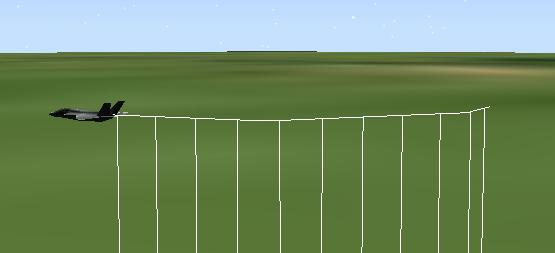Path Primitive
The Path Primitive is similar to the
Polyline Primitive, but it is designed for efficient addition
and removal of points to either end of the line. The Path Primitive
can be used to visualize things such as orbits, trail lines, lead
lines, and drop lines.

See the GraphicsHowTo
for an example that creates drop lines as seen above.
The following example shows how to create a PathPrimitive,
add/remove inidividual points, and add it to the scene:
| [C#] |
 Copy Code Copy Code
|
IAgStkGraphicsSceneManager
manager = ((IAgScenario)root.CurrentScenario).SceneManager;
IAgStkGraphicsPathPrimitive path =
manager.Initializers.PathPrimitive.Initialize();
// add points to the back of the path
Array position = new object[] { 10000000, 10000000, 0 };
path.AddBack(manager.Initializers.PathPoint.InitializeWithDatePositionAndColor(
root.ConversionUtility.NewDate("EpSec", "0"), ref position,
Color.Red));
position = new object[] { 10000000, 11000000, 0 };
path.AddBack(manager.Initializers.PathPoint.InitializeWithDatePositionAndColor(
root.ConversionUtility.NewDate("EpSec", "0"), ref position,
Color.Blue));
position = new object[] { 10000000, 12000000, 0 };
path.AddBack(manager.Initializers.PathPoint.InitializeWithDatePositionAndColor(
root.ConversionUtility.NewDate("EpSec", "0"), ref position,
Color.Green));
// render path with three points
manager.Primitives.Add((IAgStkGraphicsPrimitive)path);
manager.Render();
// remove point from the front of the path
path.RemoveFront();
// render path with remaining two points
manager.Render();
|
|
PathPoints can be added to either end of the path. Each
PathPoint can have a a different
color,
translucency,
outline color, and
outline translucency. When a PathPoint is added to the
PathPrimitive, the primitive does not sort the points by any of the
properties mentioned above. The order that the points were added to
the path is the order that they are on the line.
The PathPrimitive can add a range of PathPoints to the line as
well. The following examples show the use of the AddRange
method.
| [C#] |
 Copy Code Copy Code
|
IAgStkGraphicsSceneManager
manager = ((IAgScenario)root.CurrentScenario).SceneManager;
IAgStkGraphicsPathPrimitive path =
manager.Initializers.PathPrimitive.Initialize();
Array initialPosition = new object[] { 10000000, 0, 0 };
path.AddBack(manager.Initializers.PathPoint.InitializeWithDatePositionAndColor(
root.ConversionUtility.NewDate("EpSec", "0"), ref initialPosition,
Color.Blue));
Array points = new object[20];
for (int i = 0; i < 20; i++)
{
Array position = new object[] {
100000, 0, 0};
points.SetValue(manager.Initializers.PathPoint.InitializeWithDatePositionAndColor(
root.ConversionUtility.NewDate("EpSec",
"0"), ref position, Color.Blue), i);
}
path.AddRangeToBack(ref points);
manager.Primitives.Add((IAgStkGraphicsPrimitive)path);
manager.Render();
|
|
The PathPrimitive has other appearance properties that are used
in the same way as the PolylinePrimitive:
PolylineType,
Width,
DisplayOutline, and
OutlineWidth.
The PathPrimitive also has a property that allows user-defined
updates. Any class that implements the interface
PathPrimitiveUpdatePolicy and implements the
Update method can dynamically update the PathPrimitive
when assigned to the property. Some built-in update policies are
MaximumCountPathPrimitiveUpdatePolicy and
DurationPathPrimitiveUpdatePolicy. The
MaximumCountPathPrimitiveUpdatePolicy will remove a point from the
remove location of the path when the number of points exceeds
the
maximum count. The DurationPathPrimitiveUpdatePolicy, on the
other hand, will remove a point from the
remove location of the path when the time span between the
point's
date and the CurrentTime
exceeds the
duration. The following code sample shows how a create your own
update policy:
| [C#] |
 Copy Code Copy Code
|
public class
DistancePathPrimitiveUpdatePolicy :
AgStkGraphicsPathPrimitiveUpdatePolicy
{
public
DistancePathPrimitiveUpdatePolicy(int distance,
AgEStkGraphicsPathPrimitiveRemoveLocation removeLocation)
{
Distance
= distance;
RemoveLocation
= removeLocation;
}
public int Distance { get; set; }
public
AgEStkGraphicsPathPrimitiveRemoveLocation RemoveLocation { get;
set; }
// remove points from the front/back
of the line if the computed
// distance is greater than the given
distance.
public void
Update(IAgStkGraphicsPathPrimitive PathPrimitive,
AGI.STKUtil.IAgDate Date)
{
if
(RemoveLocation ==
AgEStkGraphicsPathPrimitiveRemoveLocation.eStkGraphicsRemoveLocationBack)
{
while
(DistanceBetweenPositions(PathPrimitive.Front().Position,
PathPrimitive.Back().Position) > Distance)
{
PathPrimitive.RemoveBack();
}
}
else
{
while
(DistanceBetweenPositions(PathPrimitive.Front().Position,
PathPrimitive.Back().Position) > Distance)
{
PathPrimitive.RemoveFront();
}
}
}
public int
DistanceBetweenPositions(Array position1, Array position2)
{
double
x1 = (double)position1.GetValue(0);
double
y1 = (double)position1.GetValue(1);
double
z1 = (double)position1.GetValue(2);
double
x2 = (double)position2.GetValue(0);
double
y2 = (double)position2.GetValue(1);
double
z2 = (double)position2.GetValue(2);
return
(int)Math.Sqrt((x2 - x1) * (x2 - x1) + (y2 - y1) * (y2 - y1) + (z2
- z1) * (z2 - z1));
}
}
|
|
STK Programming Interface 11.0.1


 Copy Code
Copy Code
 Copy Code
Copy Code
 Copy Code
Copy Code